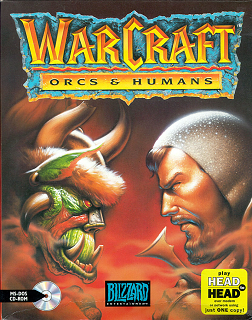
Warcraft: Orcs & Humans is a real-time strategy game (RTS) developed and published by Blizzard Entertainment, and published by Interplay Productions in Europe. It was released for MS-DOS in North America on 15 November 1994, and for Mac OS in early 1996. The MS-DOS version was re-released by Sold-Out Software in 2002.
Command & Conquer (C&C) is a real-time strategy (RTS) video game franchise, first developed by Westwood Studios. The first game was one of the earliest of the RTS genre, itself based on Westwood Studios' influential strategy game Dune II and introducing trademarks followed in the rest of the series. This includes full-motion video cutscenes with an ensemble cast to progress the story, as opposed to digitally in-game rendered cutscenes. Westwood Studios was taken over by Electronic Arts in 1998 and closed down in 2003. The studio and some of its members were absorbed into EA Los Angeles, which continued development on the series.

Populous: The Beginning is a real-time strategy video game and the third entry in the Populous series, developed by Bullfrog Productions. The game was released in 1998 on Microsoft Windows, and in 1999 for the PlayStation. Unlike earlier games in the series, which cast the player in the role of a god influencing loyal followers, The Beginning took a radical departure and placed the player in the role of a shaman, who directly leads her tribe against opponents. Throughout the twenty-five missions of the campaign, the player leads their tribe across a solar system, dominating enemy tribes and tapping new sources of magic, with the ultimate goal of the shaman attaining godhood herself.

Star Wars: Empire at War is a 2006 real-time strategy video game developed by Petroglyph Games and published by LucasArts for Microsoft Windows and Mac OS X. Set between Episode III and Episode IV, it focuses on the fledgling struggle between the Empire and the Rebels. It uses Petroglyph's game engine Alamo. In October 2006, an expansion titled Star Wars: Empire at War: Forces of Corruption was released.
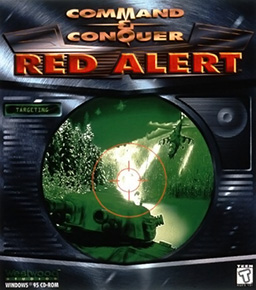
Command & Conquer: Red Alert is a real-time strategy video game in the Command & Conquer franchise, developed and published by Westwood Studios in 1996. The second game to bear the Command & Conquer title, Red Alert is the prequel to the original Command & Conquer of 1995, and takes place in the alternate early history of Command & Conquer when Allied Forces battle an aggressive Soviet Union for control over the European mainland.
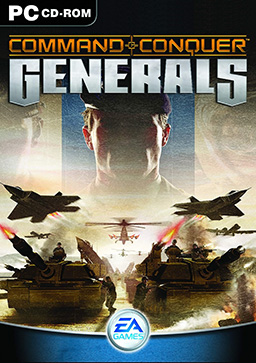
Command & Conquer: Generals is a real-time strategy video game and the seventh installment in the Command & Conquer series. It was released for Microsoft Windows and Mac OS X in 2003 and 2004. The Windows version of Generals was developed by EA Pacific and published by EA Games, the Mac OS X version was developed by i5works and published by Aspyr Media. The Mac OS X version was released by Aspyr on April 12, 2004. In the game, the player can choose from three different factions: the United States, China and the Global Liberation Army (GLA).
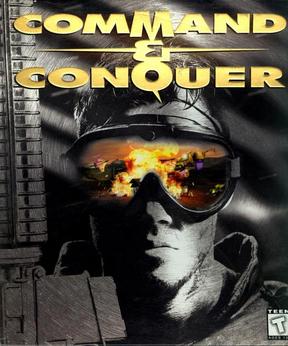
Command & Conquer is a real-time strategy video game developed and published by Westwood Studios in 1995. Set in an alternate history, the game tells the story of a world war between two globalized factions: the Global Defense Initiative of the United Nations and a revolutionary militant organization called the Brotherhood of Nod, led by the mysterious Kane.

Command & Conquer: Tiberian Sun is a 1999 real-time strategy video game developed by Westwood Studios, published by Electronic Arts, and released exclusively for Windows in August 1999. The game is the sequel to the 1995 game Command & Conquer. It featured new semi-3D graphics, a more futuristic sci-fi setting, and new gameplay features such as vehicles capable of hovering or burrowing. The main story of the game focuses on a second war between the UN-backed Global Defense Initiative (GDI) and the cult-like Brotherhood of Nod, both seeking to rule over an Earth which is undergoing rapid ecological collapse.

The Spring Engine is a game engine for real-time strategy (RTS) video games. The game engine is free and open-source software, subject to the terms of the GNU General Public License v2.0 or later.
Real-time tactics (RTT) is a subgenre of tactical wargames played in real-time, simulating the considerations and circumstances of operational warfare and military tactics. It is differentiated from real-time strategy gameplay by the absence of classic resource micromanagement and base or unit building, and by the greater importance of individual units and a focus on complex battlefield tactics.

Command & Conquer 3: Tiberium Wars is a 2007 science fiction real-time strategy video game developed and published by Electronic Arts for Windows, Mac OS X and Xbox 360 platforms, and released internationally in March 2007. The game is a direct sequel to the 1999 game Command & Conquer: Tiberian Sun, and takes place roughly seventeen years after the game's expansion pack Firestorm, in which Tiberium has grown to become a considerable threat to the planet, leading to the world's political borders and territories being remade into zones denoting the level of contamination by the alien substance. The game's story sees the Global Defense Initiative and the Brotherhood of Nod engage in a new global conflict, this time as major superpowers, only for the war to attract the attention of a new extraterrestrial faction known as the Scrin, which attacks both sides while harvesting Tiberium for its own purpose.

Warhammer 40,000: Dawn of War – Dark Crusade is the second expansion to the real-time strategy video game Warhammer 40,000: Dawn of War developed by Relic Entertainment and published by THQ. Based on Games Workshop's tabletop wargame, Warhammer 40,000, Dark Crusade was released on October 9, 2006. The expansion features two new races, the Tau Empire and the Necrons. Including the Imperial Guard from Dawn of War's first expansion pack Winter Assault, a total of seven playable races in this expansion.

Rome: Total War: Barbarian Invasion is the first expansion pack for the strategy video game Rome: Total War. The expansion was released in 2005 in North America and Europe and in 2006 in Japan for Windows. Feral Interactive released the iPad version on 28 March 2017, the iPhone version on 9 May 2019, and an Android version of the game on 18 June 2019. A remastered version of the game was released as part of Total War: Rome Remastered on 29 April 2021. While the main game deals with the rise of the Roman Empire, Barbarian Invasion covers the decline and fall of the Western Roman Empire during the Migration Period.
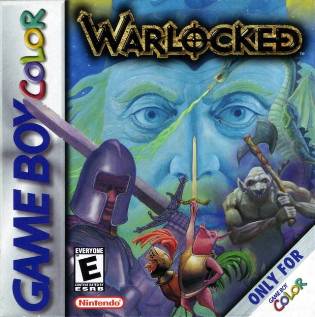
Warlocked is a real-time strategy video game developed by Bits Studios and published by Nintendo for the Game Boy Color. It was solely released in North America on July 24, 2000. Choosing between human and beast factions, the player plays through twelve scenarios from each faction, gathering resources, building fortresses, and managing troops to defeat the opposing force.

Command & Conquer 4: Tiberian Twilight is a real-time strategy video game, part of the Command & Conquer franchise, released on March 16, 2010. It constitutes a final chapter in the Tiberium saga. The game was originally intended to be an Asian market online-only version of Command & Conquer 3. It was released for download via online gaming distribution service Steam on March 19, 2010. Command & Conquer 4 also uses EA's own servers for online play, rather than GameSpy Servers which EA has relied on for previous Command & Conquer games. A closed beta of the game was released by EA to contest winners on November 21, 2009. The game received mixed reviews from critics.
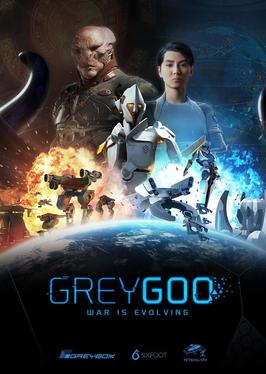
Grey Goo is a science fiction real-time strategy video game developed by Petroglyph Games, produced by Six Foot, and published by Grey Box on January 23, 2015 exclusively for PC Microsoft Windows. It features a playable faction based on the grey goo scenario.

Champions of Anteria is a 2016 action role-playing game for Windows. Developed by Blue Byte and published by Ubisoft, it was released in August 2016. In October, Blue Byte released two DLC packs; The Alchemist and The Beastmaster, featuring new characters and buildings.

8-Bit Armies is a real-time strategy video game developed by Petroglyph Games, which was released on April 22, 2016 for Microsoft Windows and for Xbox One, and PlayStation 4 on 21 September 2018.

Command & Conquer: Remastered Collection is a compilation of real-time strategy video games developed by Petroglyph Games and published by Electronic Arts. It is a remaster of the first two titles in the video game series Command & Conquer with rebuilt graphics, sound improvements and bonus materials. It was released on June 5, 2020, for Origin and Steam. A physical edition intended for collectors was released by Limited Run Games.
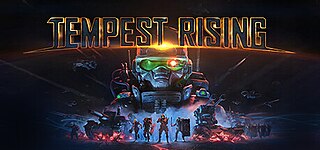
Tempest Rising is an upcoming real-time strategy video game developed by Slipgate Ironworks and 2B Games, and published by 3D Realms.


















